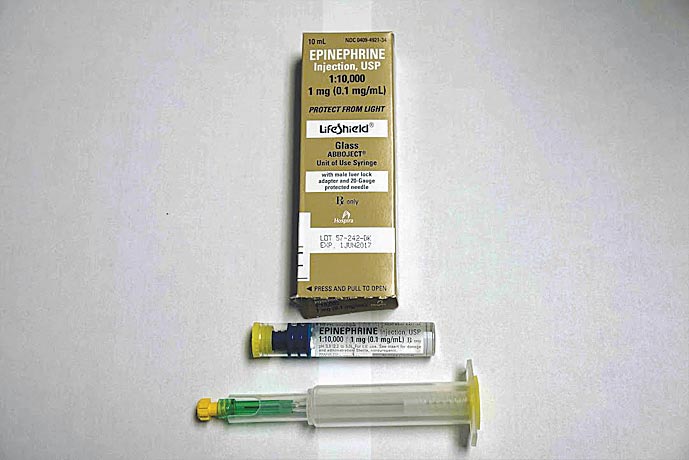- California Assembly OKs highest minimum wage in nation
- S. Korea unveils first graphic cigarette warnings
- US joins with South Korea, Japan in bid to deter North Korea
- LPGA golfer Chun In-gee finally back in action
- S. Korea won’t be top seed in final World Cup qualification round
- US men’s soccer misses 2nd straight Olympics
- US back on track in qualifying with 4-0 win over Guatemala
- High-intensity workout injuries spawn cottage industry
- CDC expands range of Zika mosquitoes into parts of Northeast
- Who knew? ‘The Walking Dead’ is helping families connect
An Analysis of the Recent EpiPen Controversy
From the Asthma and Allergy Foundation of America (AAFA), as of 2014, about 50 million people in the United States had some form of allergy, and with over 200,000 cases being anaphylaxis annually just in the United States alone. Anaphylaxis is a life threatening allergic reaction where an individual undergoes multiple symptoms in response to an allergen, beginning with nausea and swelling of facial tissues and escalating to difficulty breathing, fainting, blood vessel constriction resulting in cyanosis and eventually even death. While quick treatment in the hospital will usually result in a full recovery, that may not always be possible. This is why it is recommended that people at risk for anaphylaxis carry epinephrine, a hormone more commonly known as adrenaline and used for lessening the symptoms of anaphylaxis until the afflicted individual can reach a hospital. However, surveys have historically shown surprisingly low percentages of individuals at risk for anaphylaxis carrying some form of epinephrine auto-injector, a brand name more commonly known as EpiPen. And even fewer people may carry around epinephrine as recent laws and company switches have led to increases in price.
EpiPens are a form of epinephrine injection into an individual in the case of anaphylaxis. While the chemical epinephrine itself is not expensive (the hormone only costs about 3 dollars for a single dose of 1 ml), the cartridge in which the hormone is dispensed in is patented and therefore is what makes the EpiPen expensive, even more so now than ever before. Recently, a backlash has erupted after Mylan Pharmaceuticals, the company manufacturing EpiPens, executed a plan which can be split into three phases to increase profits. They first had a law passed by Congress to recommend EpiPens in all schools, which led to 11 states adopting a requirement for EpiPens in schools. The company’s CEO, Heather Bresch, then moved the company to the Netherlands, which essentially negated the United States corporate tax, and then raised the price of the EpiPen by more than 600% of its original price in 2009, jumping from about a hundred dollars per pen to over $600 per pen. Backlash has focused mainly on the second and third phases of their three step plan, noting that while the law to mandate EpiPens was a good move to help anaphylaxic children, the idea to exploit that good hearted law and increase a patented product to more than 6 times the original price was probably less of an intention to help others. What’s worse is the guarantee of profits: the epinephrine in the EpiPen cartridges lose potency after about a year, and thus are recommended to be replaced annually. Combine that with the ridiculous increase in a life saving contraption, and one can see how Mylan would make huge profits over the lives of children. While Mylan may have the right to do so, it certainly doesn’t mean whether a 600% increase is the right thing to do.
This incident has been compared to an earlier incident with Turing Pharmaceuticals when its now ex-CEO, Martin Shkreli, bought the drug Daraprim, a drug used for patients with compromised immune systems from causes such as HIV, and increased the drug’s prices overnight by 5,000% from $13.60 a pill to $760 a pill. Known to the internet as “the most hated man on the web,” Shkreli was later arrested not for his outrageous price increase, but for security fraud. Bresch now faces a court hearing in the Capitol to explain her increases in a contraption that many people depend on for saving their lives.
The fact that epinephrine itself is cheap must be restated; the reason for Heather Bresch’s price raise being so outrageous is that the mechanism used for quickly injecting epinephrine into the body is patented by Mylan, and thus in terms of portable anaphylaxis prevention, Bresch has essentially a monopoly, a monopoly which allowed for a law with seemingly good intentions to get out of hand. The spirit behind what Mylan has done could be compared to price gouging, defined as the act of spiking essential goods’ prices up past the point of reasonable and perhaps even in extreme cases bordering on unethical. While laws against price gouging are in place for essential items only during emergencies, the idea of a competitive monopoly raising the price on a good must be compared to Mylan’s actions. One might say that both Bresch and Shkreli’s hikes up the price ladder may have killed or at least endangered lives. Having the intention to help children with life-threatening conditions isn’t a bad thing; requiring EpiPens on school campuses isn’t what’s bad. It’s when a company like Mylan decides to exploit the ailments of people for their own profit that people grow outraged. Hospitals do not use EpiPens, instead they intravenously inject the epinephrine directly into the bloodstream of the individual, a far more effective method. But for the average person needing to quickly inject a lifesaving drug to save a life, one company’s ulterior motives have led to such confusion today.
There are definitely ways that one would be able to resolve this controversy, the most obvious being the reinstatement of the original price of the EpiPen before it was so blatantly inflated. Another may be to introduce a cheaper competitor after the patent for the EpiPen mechanism wears out. Shkreli’s Daraprim had the same resolution; a third party selling $1 versions of the $760 pill quickly made Turing realize the error of their ways. In any case, by resolving this controversy we may be able to watch children and their peers play without worry of an anaphylaxic reaction left untreated from a 600% increase in a life-saving tool.














kelly
November 26, 2017 at 1:47 PM
yes..I like the basic concepts behind Second Life but it seems incredibly outdated and when I played it was intensely non-intuitive / user friendly to an extent that made EVE look like a game for toddlers. thanks from
togel online